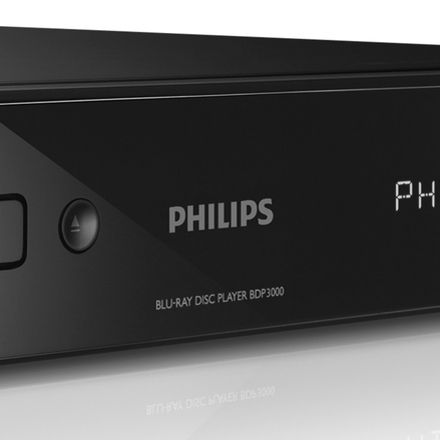There’s been a lot of rubbish talked about Blu-ray’s slow growth. Probably as a reaction to the hyperbole from the format’s promoters, its success has been downplayed; the truth is, Blu-ray is more than grazing our interest in the UK.
Our quick take
Despite excellent build quality, cool minimalist styling and a simple approach to onscreen menus and fast disc playback, it’s this deck’s excellent value pictures that should give it a wide appeal, despite the slightly cumbersome BD-Live arrangement.

Philips BDP3000 Blu-ray player - 3.5 / 5
| FOR | AGAINST |
|---|---|
|
|
It’s arguably more popular than DVD was in its early days, and over 400,000 Blu-ray players have already been sold in the UK – a figure that this budget deck will undoubtedly add to.
Good looking, keenly priced and compatible with BD-Live, the BDP3000 should do well. Despite being a long-time supporter of the format, Philips has been slow to enter the market for Blu-ray players. Price-wise, the BDP3000 is below average – £200 being the most common price point – and it’s got much in common with budget decks like Samsung’s BD-P1600.
Just like the BD-P1600, this Philips is a Profile 2.0 machine that can connect to BD-Live. It’s not quite that simple: just like the Samsung, there’s no meaningful storage onboard the BDP3000 that can actually store the online extras you download from the BD-Live service.
Instead, the rear of the BDP3000 has a USB port that must be graced with a memory stick of at least 1GB to allow BD-Live to even connect. It’s a bit messy, and incredibly stingy – especially with that tiny amount of storage now so cheap – but it works without a hitch on the BDP3000.
The deck automatically connects to BD-Live via a wired Ethernet connection, though it took 2 minutes to load the BD-Live service during our tests. The wired set-up is fair enough at this price, though Samsung’s similarly priced BD-P1600 does allow the option of adding a wireless dongle (albeit for an extortionate £50).
On the BDP3000 the USB port is reserved for BD-Live and firmware upgrades only; the lack of a USB for playing digital media from a memory stick is perhaps this deck’s biggest mistake. Even the disc tray can only play a very limited number file formats, including JPEG photos, MP3 music and DivX, AVI and WMV files.
But the BDP3000’s core function is, of course, Blu-ray. Capable of playing back discs in Full HD glory and at 24 frames-per-second, the BDP3000 also upscales DVDs to near-HD quality. Loading a DVD in around 10 seconds, the BDP3000’s upscaling performance is fairly basic; discs are presented relatively cleanly though with little in the way of extra detail. Some jagged edges can still be seen, as well as some picture noise, but there’s more detail on show in DVDs than expected.
Blu-ray discs load in around 30 seconds and are immediately noticeable for being so pure. Very little picture noise is evident, while the level of detail is awesome in some richly coloured and contrast-heavy pictures. We did notice some jagged edges and a modicum of judder when playing in 24p mode, though in totality the BDP3000 easily equals its peers at this low price.
On the audio front, Dolby’s TrueHD 7.1 surround sound format can be decoded by the BDP3000, though not the "rival" DTS HD Master Audio 7.1 codec.
To recap
This deck’s excellent value pictures should give it a wide appeal, despite the slightly cumbersome BD-Live arrangement
